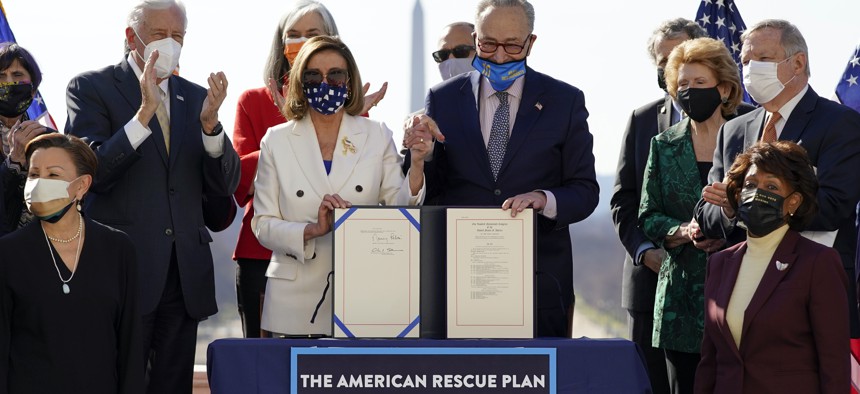Covid Relief Bill Will Infuse Billions into Local Economies

House Speaker Nancy Pelosi of Calif., and Senate Majority Leader Chuck Schumer of N.Y., poses after signing the $1.9 trillion COVID-19 relief bill during an enrollment ceremony on Capitol Hill, Wednesday, March 10, 2021, in Washington. AP Photo/Alex Brandon
From $1,400 stimulus payments to $300-a-week unemployment benefits, the $1.9 trillion aid package gets cash to residents that can translate to stronger state and local tax revenues.
Congress gave final approval Wednesday to a $1.9 trillion covid relief bill that not only provides direct aid to state and local governments but also includes provisions that experts say will help boost local economies.
From $1,400 direct stimulus checks to expanded child tax credits and federal unemployment benefits, the legislation will provide assistance to millions of Americans in ways that can help lift declining state and local tax revenues.
During the Great Recession, every $1 of unemployment insurance generated $1.61 in economic activity, making the benefit “one of the best counter-recession tools,” said Alexa Tapia, a policy expert with the National Employment Law Project. Those figures only include unemployment benefits paid by states, as the federal government did not provide supplemental aid to the degree it has during the coronavirus pandemic.
Under the covid relief bill, which President Biden is expected to sign into law Friday, out-of-work Americans will receive $300-a-week supplemental unemployment insurance in addition to state benefits.
“If people are able to get unemployment insurance benefits, they are able to have money in hand and to continue spending for their everyday necessities which in turn stimulates the economy and creates tax revenue for state and local governments,” said Lucy Dadayan, a senior researcher with the Urban-Brookings Tax Policy Center.
State tax revenues fell by 1.8% overall from April to December 2020 as businesses closed, workers were laid off and people stayed home amid the pandemic. The severity of the economic declines varied from state to state. Tax revenues increased in some states, but 28 states reported declines in overall tax collections and seven reported double-digit percentage drops. Places with economies that depend heavily on tourism, parts of the service sector, gas and oil production, and other industries hit hardest by the pandemic have fared the worst.
As tax revenues outperformed bleak projections issued during the early days of the virus outbreak, conservatives and others questioned whether it was necessary to include $350 billion for state and local governments in the relief package.
Citing both the direct stimulus payments, which will go to many Americans who haven’t dealt with financial losses tied to the pandemic, and the broad funding program for state and local governments, one budget watchdog said the bill included “important priorities” but is “poorly targeted.”
“We’re now on course to run $3 trillion deficits two years in a row,” said Maya MacGuineas, president of the Committee for a Responsible Federal Budget. Prior to the pandemic, total federal spending was around $4.4 trillion annually.
“We shouldn’t hesitate to borrow what’s necessary to end the pandemic and support the economic recovery,” MacGuineas added. “But we can’t pretend this borrowing is costless.”
Direct aid for state and local governments will help pay for pandemic-related expenses, but it can also prevent layoffs or even cover new hiring—both of which will be beneficial to local economies, said Richard Auxier, a senior policy associate at the Urban-Brookings Tax Policy Center.
Another way experts said the relief bill will help at the local level is through direct $1,400 payments to individuals who make less than $75,000 a year. Some recipients of previous stimulus checks said they used the money to bolster their savings. But data collected by the U.S. Census Bureau found that the bulk of recipients, about 70%, spent the money, and used a prior stimulus check for expenses such as housing or food.
Other research has shown that how people used the prior payments varied based on income levels, with wealthier households more likely to sock away the money, rather than spend it.
The bill also expands the annual child tax credit to $3,600 for children up to age 5 and $3,000 for children ages 6 to 17. Those changes would lift about 4 million children above the poverty line and cut child poverty by 40%, according to the Center for Budget and Policy Priorities. The way the credits are distributed could affect spending habits, with eligible families receiving payments of up to $300 per child, per month as opposed to getting a tax refund back in one lump sum.
The infusion of cash back to taxpayers will only go so far, however, if localities are unable to address the underlying public health crisis, Auxier said.
States and cities can allow businesses to reopen but if people are not vaccinated and remain concerned about catching the virus, they are unlikely to resume old spending and shopping patterns that would benefit local economies.
“What are they going to spend their money on, Amazon packages or going out to eat at a local place?” Auxier said. “We are not going to get the latter until we get the public health impact under control.”
While no Republicans ultimately voted for the aid package in either the House or the Senate, Biden said every item in the bill “addresses a real need.”
“This legislation is about giving the backbone of this nation — the essential workers, the working people who built this country, the people who keep this country going — a fighting chance,” the president said.
Andrea Noble is a staff correspondent with Route Fifty.
NEXT STORY: How the Pandemic Economy Could Wipe Out a Generation of Black-Owned Businesses





